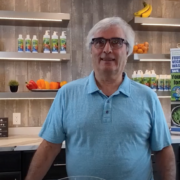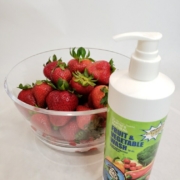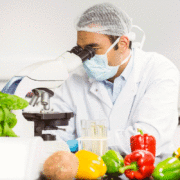Should Our Food Be Sterile?
/in Children's health, Eco friendly cleaning products, Environmentally friendly cleaning products, flu, food safety, Fruit and vegetable wash, Green cleaning products, health and wellness, Natural cleaning products, News, Non toxic to children, Respiratory illnessShould I Wash Fruits & Vegetables I Buy at the Grocery Store in a Fruit & Veggie Wash?
/in Children's health, Eco friendly cleaning products, Environmentally friendly cleaning products, Fruit and vegetable wash, Green cleaning products, health and wellness, healthy living, Natural cleaning products, Non toxic to children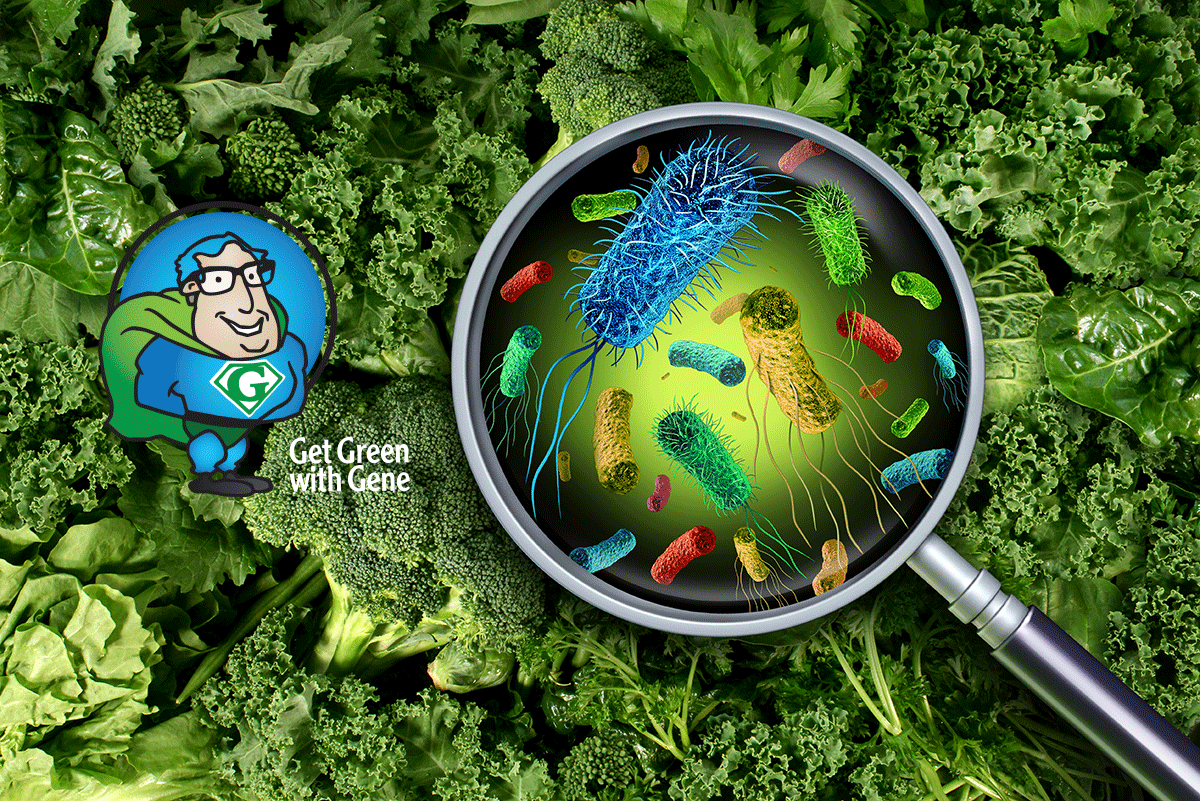 Should I Wash Fruits & Vegetables I Buy at the Grocery Store in a Fruit & Veggie Wash?
Should I Wash Fruits & Vegetables I Buy at the Grocery Store in a Fruit & Veggie Wash?
By Bill Adler, MPH, RS
Technical Food Safety Consultant
Fruits and veggies from the grocery store have wax on them. This keeps the moisture in from the time of picking to the time you buy them. But those waxes and underlying pesticides aren’t good for you. The waxes are known as parabens, and as a chemical class, parabens aren’t good for your kids. In the medical field, parabens are known as endocrine disruptors and shouldn’t be eaten, even if it’s a small amount each time it’s eaten. And then there are the pesticides under the wax. Since pesticides are oils, they don’t come off with a quick flush under the tap, either.
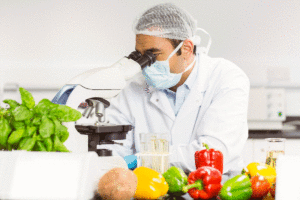
Life’s Pure Balance Fruit and Vegetable Wash dissolves the wax and removes the pesticides so you don’t have to eat them. Put 2-teaspoons in a gallon of water. Let produce sit in it for 2+ minutes, a quick rinse and you’re good to go. That’s it! This is a concentrated citric acid so it doesn’t take much to clean produce. I’ve found it gives us extended refrigerated shelf life by about 2 days. Everything gets washed as soon as we get it home and this gives us a good 12 days of storage. I know of no other fruit and veggie wash that does that. There’s no odor or carry-over residue either.
I get asked all the time if it can be used to wash lettuce, kale, spinach, tomatoes, and so on. Yes, it’s made for all of these. Strawberries, raspberries, and blueberries all benefit, too. Strawberries actually have a porous surface. Raspberries have gaps between the segments. Blueberries apparently aren’t easy to cultivate and growers use up to 4 different herbicides a season. Washing fruits and veggies by rinsing under tap water alone doesn’t do much to protect you from pesticides, pathogens, and other chemicals. If you don’t believe me, do your own internet search. It’s all there. But now that you know, maybe you should wash your produce with Life’s Pure Balance Fruit and Vegetable Wash. You’ll be surprised by the improved taste once you do.
Bill Adler is an expert in food safety, foodborne illnesses, and the food service inspection industry. He has conducted training for the Center for Disease Control and Prevention (CDC) teaching local, state, and federal disease investigators as well as working with laboratory specialists and epidemiologists. Bill has worked extensively with the Minnesota Department of Health (MDH) to perform food service inspections and train local and state public health employees.
Produce has pores!
/in Allergies, Asthma, Children's health, Eco friendly cleaning products, Environmentally friendly cleaning products, Fruit and vegetable wash, Green cleaning products, health and wellness, healthy living, Uncategorized
Back a few years ago when the economy was tough and pennies were being pinched, I worked for a “natural” products company. Most people were not interested in looking at our products let alone buying, so I reverted to demonstrating washing grapes with their natural dish soap! It worked for the most part. Until one day, one of my friends took me aside and explained to me that they could taste something funky which meant the grapes were not truly clean. They said: “You can do better than this. Why don’t you make your own?”
Over the next 3 or 4 months, I went to every major grocery store chain, looking for their respective fruit and vegetable wash. One-by-one I put them through my taste test, quickly becoming appalled. Every product that I sampled left a funky taste in my mouth! When I asked people if they used a wash they told me that most don’t work because they leave a funky taste behind, and some just used water.
If you want to clean something you need to know what the surface looks like, right? You are probably thinking, it’s just a grape or a tomato, or a cucumber, how difficult can that be?
Did you know that fruits and vegetables have pores? They are called “stoma” or “stomata”. These pores take in carbon dioxide needed for photosynthesis, and to release oxygen. These pores then close reducing water loss in hot or dry conditions. In the right conditions, they will actually sweat, much like human pores. (Click here to read more on pores in produce via this Wikipedia link). These stomata are tiny, microscopic and critical for the photosynthesis process and very difficult to clean.

an electron photomicrograph
See the folds in the surface – this is why it’s notoriously #1 on the Dirty Dozen
With two requirements and a bunch of knowledge, we set out to develop a new wash. First, it had to be an effective wash, removing wax and pesticides, all while paying attention to all of those stomata. Second, it must be a “residue free” wash. After rinsing, the solution needs to be gone!
A side note for a moment. Anyone who wears cosmetics knows how important it is to clean their skin at night. Cleaning fruits and vegetables are similar in that sense. When it is achieved, your skin will be fresh and vibrant. This is the same for fruits and vegetables. When effectively washed they will be cleaner, crispier and tastier.
It is my firm belief that when given two choices of the same food to eat, and one tastes better we all eat the best tasting option! If you simply try my wash, you will not be disappointed.
#goodtastelesswaste #cleanercrispiertastier #bestkitchensecret
Martha’s Family Reunion
/in Children's health, Eco friendly cleaning products, Environmentally friendly cleaning products, Fruit and vegetable wash, Green cleaning products, health and wellness, healthy living, Natural cleaning products, Non toxic to children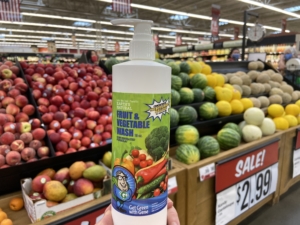 Martha told me one day that she was excited about her upcoming family reunion. She has been my customer for quite a while. She could be described as a “raving” fan, having experienced the improved freshness and taste of her fruits and vegetables. Her plan was simple, to use my wash for the fruit salad she was preparing for her reunion. She just knew that this would present her with a chance to tell everyone about the virtues of my produce wash.
Martha told me one day that she was excited about her upcoming family reunion. She has been my customer for quite a while. She could be described as a “raving” fan, having experienced the improved freshness and taste of her fruits and vegetables. Her plan was simple, to use my wash for the fruit salad she was preparing for her reunion. She just knew that this would present her with a chance to tell everyone about the virtues of my produce wash.Family reunion day came, Martha made her fruit salad and off she went. Upon arriving she bounced out of her SUV with her salad in hand, wanting to find a prime spot on the two large tables set up for food. Much to her chagrin, there was already another fruit salad sitting on one of the tables. In just a couple of heartbeats, her plan had vanished! Anyone watching would have noticed the air going out of Martha’s plan. What was she to do?
She quickly contemplated the table arrangement, placing her salad in an appropriate spot, some distance away from the “other one” and went about checking in with her family. It was a beautiful day, her family members were all arriving. Oh well, she thought, nothing ventured nothing gained.
Several hours later, everyone started to pack up. She went to the food tables to pick up her fruit salad. Since there were two bowls of fruit salad, there would be leftovers for her to enjoy during the following week. Much to her surprise, her bowl was 100% empty! She quickly looked for the other salad, found it and noticed that it had hardly been touched.
The following week she told me about her family reunion experience, sharing the details about her salad versus the other salad, all while apologizing for her plan gone awry. All I could do was smile, as I have seen and heard of this phenomenon many times. I explained to her the story about the two bowls of grapes, and that most often people do not realize that they will automatically gravitate to food that tastes good not knowing or caring why! Personally, I have had people argue with my explanation and honestly, the first few times I experienced these stories I wondered as well. Since this is my business, I hear these stories nearly every time I engage with my customers causing me to say “they are true!”
Adults will do the same as kids. Although, kids are much faster at making the choice. If given two choices of the same food to eat, and one tastes better we all eat the best tasting option, most of the time never questioning why!
If you don’t believe that this is a true story, try our wash. You will understand why.
#cleanercrispiertastier
Connecting the DOTS … ?????
/in Children's health, Eco friendly cleaning products, Environmentally friendly cleaning products, Fruit and vegetable wash, Green cleaning products, health and wellness, healthy living, Natural cleaning products, Non toxic to children, Uncategorized
Two bowls sit on the edge of the counter full of red grapes that have been plucked from their stems. Mom has figured out that by just leaving fruit on the counter her boys will wander by, as boys do, eating what they see. Getting her kids to willingly eat more fruits and vegetables is an important activity for their family.
One Saturday evening, Dad went to put the bowls of grapes into the fridge and noticed something really peculiar. One bowl was empty, the second bowl had been nibbled at but was mostly as full as it was in the morning. He took note and after the boys were in bed, he told his wife about his observation. She laughed and said: “I’ll be doggone, it must be true.”
She told her husband about this demo stand at her local grocery store. They were washing grapes with this new kind of fruit and vegetable wash. They talked about doing what she had done, wash one bowl with this new produce wash and one using any other method. She then put them out in two separate bowls to see what would happen. While she found the idea of a wash not leaving any residue or chemical taste to be intriguing, her experience was just the opposite. In the end she decided to try it, after all they have a money back guarantee.
Moms know that when it comes to food, kids come unfiltered. If they dislike something, they will tell her or just not eat. Once again the wash won the eating contest, as the bowl that was eaten was the bowl washed with this new, intriguing fruit and vegetable wash called Earth’s Natural Fruit and Vegetable Wash. The un-eaten bowl was washed with just water, just as mom had always done.
If you don’t believe that this is a true story, try our wash, you will be in for an interesting surprise.
#cleanercrispertastier
I can't get these apples clean!
/in Allergies, Asthma, Children's health, Eco friendly cleaning products, Environmentally friendly cleaning products, Fruit and vegetable wash, Green cleaning products, health and wellness, healthy living, Natural cleaning products, Non toxic to children, Non toxic to pets
Back row has been cleaned, front row is still very waxy!
Have you ever had this happen to you… or perhaps one of your kids took a bite out of an apple, promptly saying this apple doesn’t taste good then throwing it away before you have a chance to do anything?
I recently received an email from one of my customers saying, “I buy a smaller apple called rockets and they have a wax over them I have noticed that no matter how long I soak them I can’t get all this wax off, any suggestions?” You can only imagine my interest level and concern as I read their note. You see, I love solving problems… yet I’m concerned that my wash might not be working as advertised.
Further conversation revealed the following, my customer writes: “I have never had a problem with the wash getting the wax off but was unsure if I could use it directly on the fruit. I do love love love this wash as all the others I have used leaves a gross after taste!”
With this new knowledge, I offered the following… “Put a squirt or two directly on the apple then rub it in your hands… I personally had an apple yesterday that took 30 seconds or so of this kind of action to get it clean… when you do this you can feel the wax disappear”.
This phenomenon is quite common when dealing with fruits and vegetables such as cucumbers or apples, often times the wax is thicker or harder than normal and takes some extra effort to get it removed.
What I failed to mention to my customer is that the surface of the apple will go from being sticky to kind of slimy to almost squeaky. One of my product demonstrators encourages people to lick the apple before they clean it, then once again after it’s been washed, saying that you can really tell the difference. I’ve done this and he is right!
So just in case you didn’t realize it, you can use the wash undiluted on your fruits or vegetables. You can hand wash zucchini, apples, cucumbers or watermelon etc. When you do, notice the change in how the surface feels!
If you have questions or examples of how my Fruit and Vegetable wash has worked for you please post on my Life’s Pure Balance Facebook page.
When your produce is truly clean, it will taste better, raw or cooked doesn’t matter. The flavor will be cleaner, crispier and tastier!
Go to fruitandveggiewash.com for additional product information.
#cleanercrispiertastier
To Avoid Food-borne Illness, Wash Your Vegetables and Fruits
/in Allergies, Children's health, Eco friendly cleaning products, Environmentally friendly cleaning products, Green cleaning products, Natural cleaning products, Non toxic to children, Non toxic to pets It’s midsummer in Minnesota, and despite the weather roller-coaster we’ve been riding, seasonal fruits and vegetables are ripe for the picking. Those of us with gardens are seeing tomatoes plump up and cucumbers and zucchini ripen overnight. Grocery store shoppers are enjoying fresher, more local produce, too. Before you sink your teeth into your favorite summertime fruit or veggie, take a moment to consider your safety. Whether you’re pulling your snack out of the ground or plucking it from a store shelf, all produce has been exposed to soil and water that may carry contaminants. If you’re buying from a store, your produce has been handled by many people and transported by truck or rail to your shopping cart. Hundreds of food products have been recalled by the FDA since the beginning of the year, including many fresh produce foods. The harmful bacteria salmonella and listeria monocytogenes are the primary offenders. How Do You Avoid Illness? Wash, Wash, Wash! To avoid getting sick from your favorite fruits and veggies, you need to get out the soap and water. Here are some tips for washing your produce.
It’s midsummer in Minnesota, and despite the weather roller-coaster we’ve been riding, seasonal fruits and vegetables are ripe for the picking. Those of us with gardens are seeing tomatoes plump up and cucumbers and zucchini ripen overnight. Grocery store shoppers are enjoying fresher, more local produce, too. Before you sink your teeth into your favorite summertime fruit or veggie, take a moment to consider your safety. Whether you’re pulling your snack out of the ground or plucking it from a store shelf, all produce has been exposed to soil and water that may carry contaminants. If you’re buying from a store, your produce has been handled by many people and transported by truck or rail to your shopping cart. Hundreds of food products have been recalled by the FDA since the beginning of the year, including many fresh produce foods. The harmful bacteria salmonella and listeria monocytogenes are the primary offenders. How Do You Avoid Illness? Wash, Wash, Wash! To avoid getting sick from your favorite fruits and veggies, you need to get out the soap and water. Here are some tips for washing your produce.
- Only wash produce when you’re ready to eat or cook it. Washing it before you store it may actually increase bacterial growth.
- Wash your hands with warm soap and water before you wash your produce. You do not want to transfer germs on your hands to your food.
- Clean your tools, including knives, cutting boards, and countertops, to avoid germ transfer.
- Wash away bacteria. But bleach and dish detergents are no-no’s because produce can absorb the chemicals. I recommend washing your fruits and veggies with an organic, plant-based rinse.
- Rub or soak vegetables to wash away bacteria. Firm fruits such as melons can be scrubbed with a brush.
- Dry produce with a paper towel or clean cloth. This can also remove bacteria.
- Trim outermost leaves of cabbage or head lettuce.
Produce-Specific Tips Some fruits and vegetables require extra care. Use these tips to make sure you’re washing your produce properly.
- Soft fruits such as peaches and plums: Wash under running water and dry.
- Firm produce such as apples and cucumbers: Wash well to remove any waxy preservative. Peeling is also an option.
- Leafy greens:Discard outer leaves and soak the individual remaining leaves in water before rinsing them under the tap. Some people use vinegar on greens, but that will change the veggie’s taste and texture.
- Grapes, cherries, and berries:Don’t wash these fruits until you eat or use them. Before you store them, get rid of any moldy or spoiled fruit. Wash under running water when ready to eat.
Summer is the time when many of us relish the tasty juiciness of fresh produce. Washing your fruits and vegetables will ensure that you’re safe while doing so. To learn more about keeping produce safe and healthy, contact me!
Here’s to breathing easy and living life to the fullest!
Gene Wood, Life’s Pure Balance
Washing your fruits & veggies, WHY & HOW!
/in Children's health, Eco friendly cleaning products, Environmentally friendly cleaning products, Green cleaning products, Natural cleaning products, Non toxic to children, Non toxic to pets, Pet Health
Toxic chemicals are on your Produce!
Thanks to improvements in farming, shipping and distribution, shoppers today enjoy a wider selection of fresh produce than ever before. However, pesticide residue on some fruits and vegetables can be a cause for concern. In fact, fruits and vegetables on the ‘highest levels’ list contain 47 to 67 pesticides per serving.
Most countries monitor residual levels of pesticides in produce, and establish legal limits for the safety of consumers. In some cases, however, these residual levels may be toxic for children, pregnant women and even pets. The US FDA maintains that consuming pesticides in low amounts is harmless, but some studies show an association between pesticides and health problems such as cancer, attention-deficit (hyperactivity) disorder and nervous system disorders and say exposure could weaken immune systems.
A study by Consumers Union, the publishers of Consumer Reports magazine, examines and rates the residual levels of pesticides on many common fruits and vegetables. A report by the Environmental Working Group, using data from the U.S. Food and Drug Administration, has found that much of the health risks associated with pesticides are concentrated in a relatively small number of fruits and vegetables.
The good news … Wash all of your fruits and vegetables … !!! When asked, most consumers tell me I wash with water. That isn’t good enough! The simple answer is you must use a detergent based cleaner to cut the chemicals, effectively removing them from the surface of your food. While there are many products on the market I advocate using a natural based dish washing solution. The difference will astound you. Complex issues, simple solutions!
To see how a professional cook and shopper washes her produce watch this short video by Stacy Klone of Kitchen Werks. Good advice from a proven source!
p.s. If you get frustrated reading labels or don’t know where to find high quality, low cost natural based cleaning products, call Gene @ 651.261.0251 to talk about what Paco uses and approves.
Copyright + Privacy Policy
© Copyright – Life’s Pure Balance 2023, All Rights Reserved.

